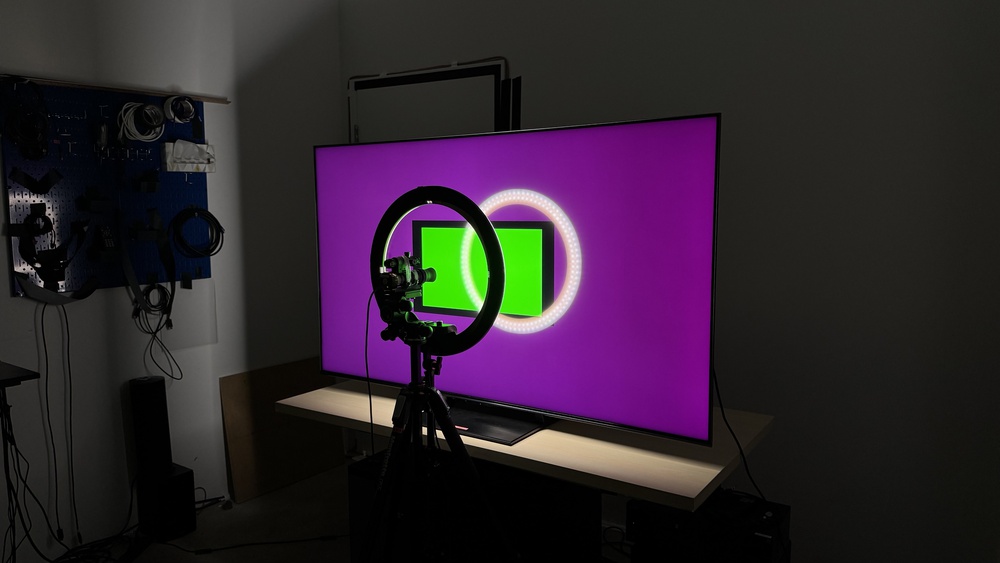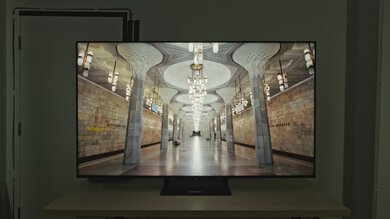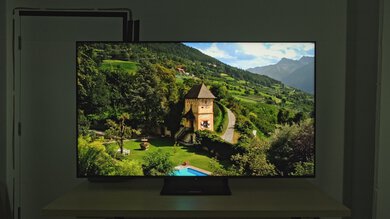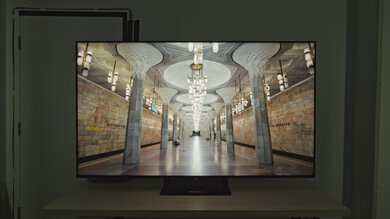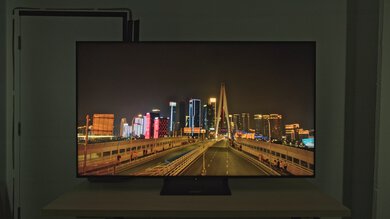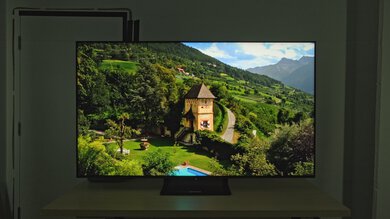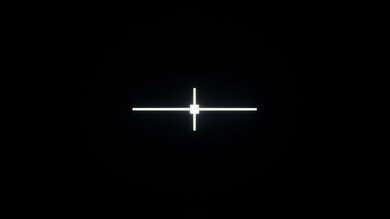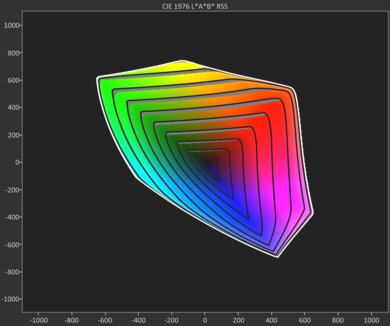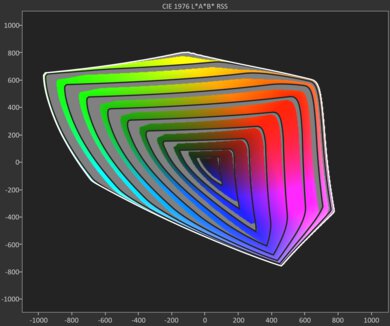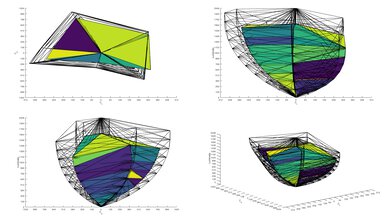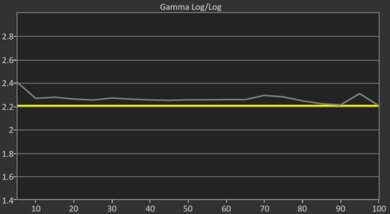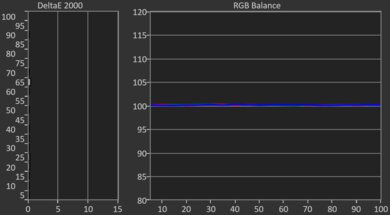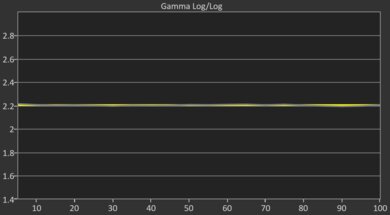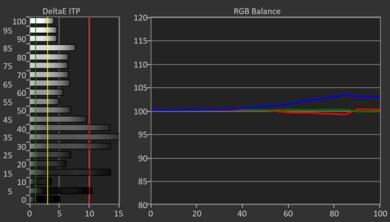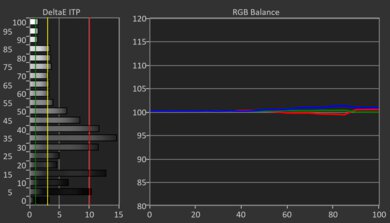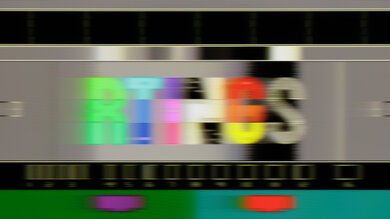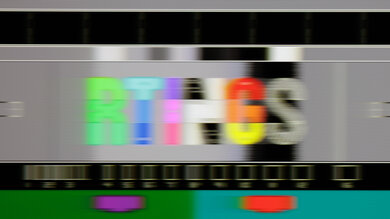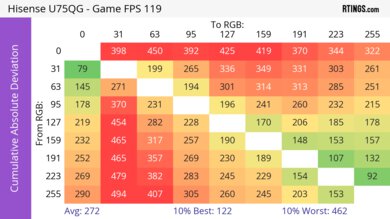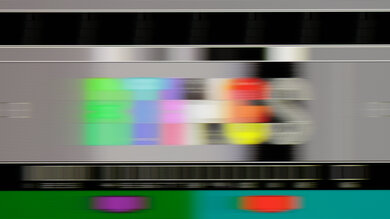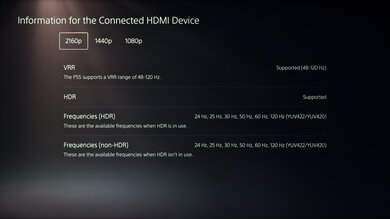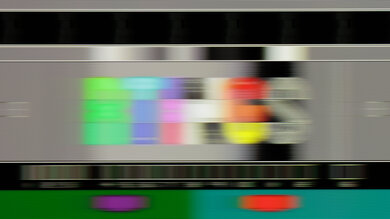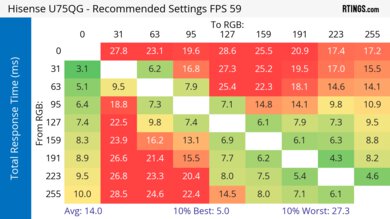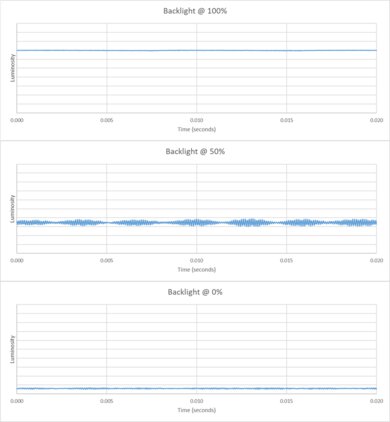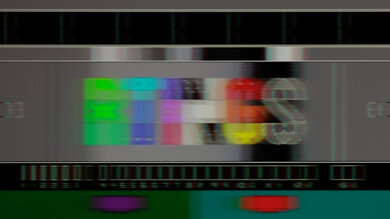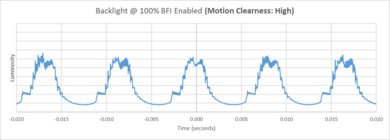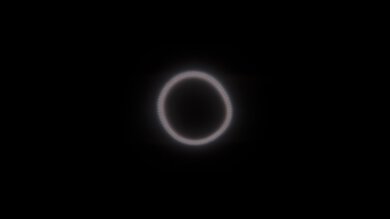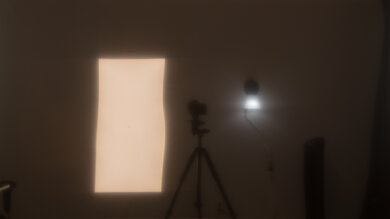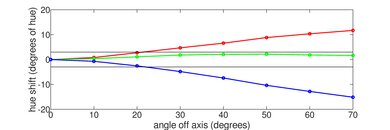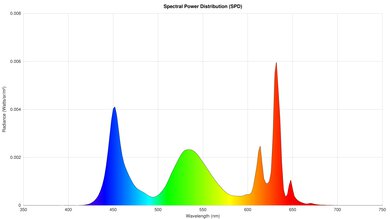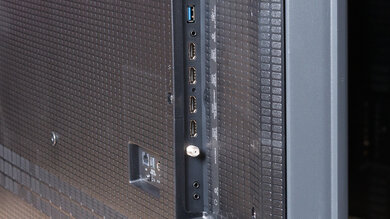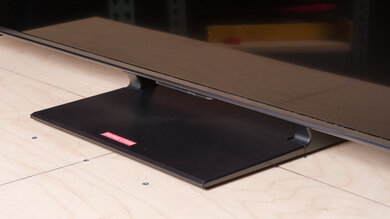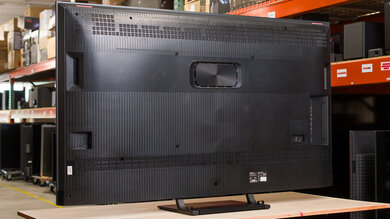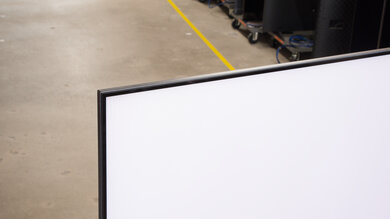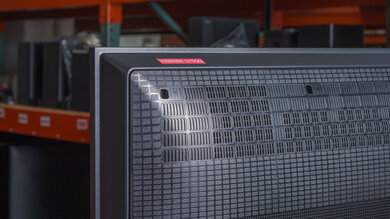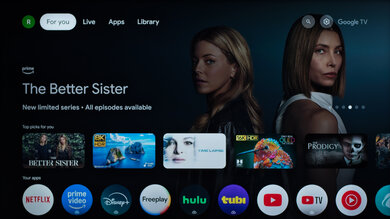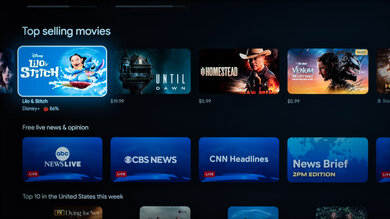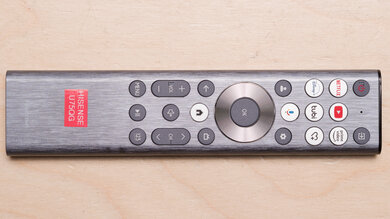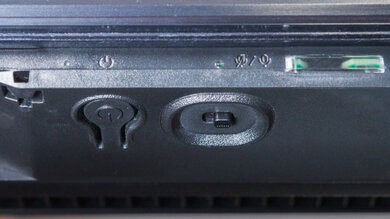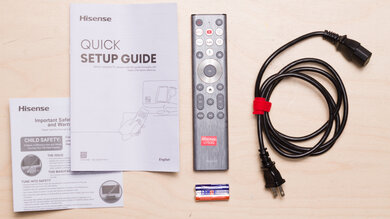The Hisense U75QG is a mid-range model released in 2025 and replaces the Hisense U7N. It sits above the Hisense U6QF but below the Hisense U8QG and Hisense U9QG in Hisense's ULED lineup. It uses the Hi-View AI Engine Pro processor and has HDMI 2.1 bandwidth on all four ports. Additionally, it has a ton of gaming features like 4k @ 165Hz, 1080p @ 288Hz, and VRR. It also supports Dolby Vision, HDR10+, and DTS audio formats, and has a 2.1.2 multi-channel surround sound system with a built-in subwoofer and two up-firing speakers meant to project sound above you. The TV utilizes the popular Google TV interface that's loaded with a ton of apps and has smart features like voice control. We bought and tested the 65-inch model, but it's also available in 55, 75, 85, and 100-inch options.
Our Verdict
The Hisense U75QG is a solid all-rounder, but it's not without flaws. In reference conditions, its deep blacks, punchy HDR brightness, and vivid colours shine, although it's not very accurate in HDR out of the box, and its PQ EOTF tracking is quite poor. It's also bright enough in SDR to handle bright rooms with ease, although glare is visible on the screen when displaying darker scenes. A full slate of gaming extras ensures seamless use with consoles and PCs alike, with very low input lag, but the TV's very slow pixel response times keep it from being a true standout for gamers. Finally, it's not the best choice for a wide seating arrangement due to its narrow viewing angle, but it's also not the worst performer in that regard, so it'll do in a pinch.
-
Outstanding SDR brightness in all scenes.
-
HDR colors are vibrant, lifelike, and bright.
-
Very deep blacks with minimal blooming around highlights and subtitles.
-
Direct reflections are a bit distracting, especially in darker scenes.
-
Image degrades when viewed from more aggressive angles.
-
The TV has a lot of bugs and strange quirks.
The U75QG is a strong centerpiece for a home theater setup. It has great black levels, with impressive contrast and a solid local dimming solution, though small halos can form around bright subtitles or highlights. HDR brightness is fantastic, as bright highlights and full-screen flashes really jump off the screen, and colors remain vivid in HDR, even though they're not very accurate. The drawback is overly aggressive PQ EOTF tracking that pushes scenes brighter than the director intended.
-
Amazing HDR brightness in all scenes.
-
HDR colors are vibrant, lifelike, and bright.
-
Very deep blacks with minimal blooming around highlights and subtitles.
-
Great low-quality content smoothing and very good upscaling capabilities.
-
HDR accuracy is only mediocre right out of the box.
-
Poor PQ EOTF tracking means the TV over brightens HDR content.
The U75QG is a treat in bright spaces. Its superb SDR brightness really blazes through ambient glare, yet colors stay punchy, and blacks remain deep even with the lights on. That said, its brightness doesn't help it much in darker scenes, where the TV's mediocre direct reflections handling is laid bare: a lamp or window positioned right opposite the screen will be reflected right off the screen, so try to keep these direct light sources to a minimum for the best viewing experience possible.
-
Outstanding SDR brightness in all scenes.
-
Very accurate in SDR out of the box.
-
Blacks remain deep and colors stay vibrant in a room with ambient lighting.
-
Direct reflections are a bit distracting, especially in darker scenes.
The U75QG handles sports like a champ. Its high SDR brightness shrugs off ambient glare, though direct reflections from a window or lamp can still be distracting, so avoid placing the screen directly opposite bright light sources. Colors in sports aren't super vivid, but they're very accurate, so at least your favorite jerseys will look as they should. What is less impressive is the TV's middling gray uniformity, which has some obvious dirty screen effect throughout the screen, with darker corners. At least the TV's very competent upscaling keeps lower-resolution cable broadcasts looking sharp enough for game day. Unfortunately, this is a TV better watched alone, or with one or two friends tops, as its viewing angle just isn't good enough for wide viewing angles.
-
Outstanding SDR brightness in all scenes.
-
Very accurate in SDR out of the box.
-
Great low-quality content smoothing and very good upscaling capabilities.
-
Direct reflections are a bit distracting, especially in darker scenes.
-
Noticeable dirty screen effect and the corners of the screen are dimmer.
-
Image degrades when viewed from more aggressive angles.
The Hisense U75QG is a very good gaming TV. All HDMI ports have HDMI 2.1 bandwidth, letting you push 4k @ 165Hz or 1080p @ 288Hz with VRR. Input lag is very low at any refresh rate, but it's held back by the TV's very slow pixel transitions at 165Hz and 60Hz. There's less blur at 120Hz, but overall, most motion looks quite blurry on this TV, making this TV better suited for slower titles. Still, with its vibrant colors, deep blacks, and amazing brightness, most games look amazing, just as long as you're not moving.
-
Amazing HDR brightness in all scenes.
-
HDR colors are vibrant, lifelike, and bright.
-
Very low input lag.
-
Does 4k @ 165Hz and 1080p @ 288Hz on all four HDMI 2.1 ports.
-
HDR accuracy is only mediocre right out of the box.
-
Very slow pixel transitions mean fast motion lacks clarity when gaming.
Brightness is one of the U75QG's standout strengths, as it's incredibly bright no matter the content. In SDR, it easily blasts past ambient glare with its incredible brightness, and in HDR, its punchy highlights really pop in dim or moderately lit scenes while still pushing full-screen images to very bright levels.
-
Amazing HDR brightness in all scenes.
-
Outstanding SDR brightness in all scenes.
Black levels on the Hisense U75QG are great. With local dimming enabled, the TV produces very inky blacks for an LED set. Its local dimming is also quite precise, with good lighting zone precision and transitions. You'll still see some blooming around bright highlights or subtitle text, or some haloing behind fast-moving objects. Finally, the TV's black uniformity is excellent, especially with local dimming set to 'High.'
-
Very deep blacks with minimal blooming around highlights and subtitles.
Colors on the Hisense U75QG really pop in HDR, where the TV's brightness really helps it push vibrant colors. It's colorful enough in SDR, especially if you just leave your TV in the common Rec. 709 color range, but those of you who like to force your TV into a wider color gamut might be disappointed, even if it does provide a decent experience overall. Out-of-the-box color accuracy is solid enough in SDR to satisfy most viewers, although it's decidedly worse in HDR, leading many to feel like they'll have to calibrate this set to get the most out of it.
-
HDR colors are vibrant, lifelike, and bright.
-
Very accurate in SDR out of the box.
-
HDR accuracy is only mediocre right out of the box.
Note: We're in the process of improving our tests related to image processing, but this score should give you a general idea of how a TV performs overall with its image processing capabilities.
The Hisense U75QG's picture processing is solid but far from flawless. It removes a ton of compression artifacts from poor-quality streaming sources and upscales lower-resolution video without leaving the image looking too soft. Gradients are pretty smooth, although there's some noticeable banding in most dark colors. The main weakness here is the TV's PQ EOTF tracking: HDR material runs much brighter than the reference curve, pushing every scene, except shadowy ones, above the intended luminance.
-
Great low-quality content smoothing and very good upscaling capabilities.
-
Poor PQ EOTF tracking means the TV over brightens HDR content.
In its dedicated PC/Game Mode, the Hisense U75QG feels responsive enough, with some caveats. All four HDMI ports offer full-bandwidth HDMI 2.1 and support VRR. The panel can drive 4k @ 165 Hz and 1080p @ 288 Hz, and input lag stays impressively low, no matter the refresh rate. Unfortunately, the TV's pixel response time is quite slow at 165Hz and 60Hz, and it isn't that much better at 120Hz, leading to some noticeable motion blur when gaming.
-
Very low input lag.
-
Does 4k @ 165Hz and 1080p @ 288Hz on all four HDMI 2.1 ports.
-
Very slow pixel transitions mean fast motion lacks clarity when gaming.
We're in the process of fixing the way we evaluate a TV's overall motion handling. This section is currently broken, and the score isn't indicative of how well a TV handles motion overall.
- 8.0 Mixed Usage
- 8.0 Home Theater
- 8.4 Bright Room
- 8.0 Sports
- 7.8 Gaming
Performance Usages
- 8.9 Brightness
- 8.1 Black Level
- 7.9 Color
- 7.0 Processing (In Development)
- 7.3 Game Mode Responsiveness
- 7.6 Motion Handling (Broken)
Changelog
- Updated Jun 13, 2025: Review published.
- Updated Jun 06, 2025: Early access published.
- Updated May 26, 2025: Our testers have started testing this product.
- Updated Apr 16, 2025: The product has arrived in our lab, and our testers will start evaluating it soon.
- Updated Apr 07, 2025: We've purchased the product and are waiting for it to arrive in our lab.
Differences Between Sizes And Variants
We bought and tested the 65-inch Hisense U75QG, and the results are also likely valid for the 55-inch and 85-inch models. The 75-inch and possibly 100-inch models use an ADS Pro panel, so they perform a bit differently than the other sizes, with worse contrast but a better viewing angle. All sizes of the TV are advertised as having a peak brightness of up to 3000 nits, but it's highly likely that the peak brightness is different depending on the size. In Canada, the TV is known as the Hisense U78QG and performs the same.
| Size | US Model | Panel Type | Dimming Zones |
|---|---|---|---|
| 55" | Hisense 55U75QG | VA | 1260 |
| 65" | Hisense 65U75QG | VA | 1800 |
| 75" | Hisense 75U75QG | ADS Pro | 2340 |
| 85" | Hisense 85U75QG | VA | 2940 |
| 100" | Hisense 100U75QG | ADS Pro | 2304 |
Our unit was manufactured in January 2025.
Compared To Other TVs
The Hisense U75QG is a very good TV for most people. It's especially impressive when it comes to sheer brightness, as it's one of the brightest TVs ever at its price range. Unfortunately, it has a very crushing weakness, as its PQ EOTF tracking is quite poor, and its pixel transitions are very slow, even for an LED TV. For that reason, most people would be better off with other, less bright models, as most of the U75QG's competitors have a more well-rounded set of features, including the TCL QM7K, and the U75QG's predecessor, the Hisense U7N. Still, if you're chasing the brightest highlights and you're not willing to step up to the Hisense U8QG's price point, the U75QG will fit that niche just fine.
For more options, check out our recommendations for the best TVs for bright rooms, the best 65-inch TVs, and the best TVs for gaming.
The Hisense U75QG dazzles more than the TCL QM7K due to its extremely high peak brightness, but the TCL is the better all-rounder, as it doesn't have a crushing weakness, unlike the Hisense. Indeed, the Hisense's poor PQ EOTF tracking and very slow pixel transitions really hold it back, while the TCL's biggest weakness is its sub-par HDR image accuracy, which isn't as noticeable. The TCL also has extremely fast pixel response times for an LED TV, has fantastic black levels, and is solid in most ways, even if it's not nearly as bright as the Hisense.
While the Hisense U8QG and the Hisense U75QG are relatively similar, the U8QG is better across the board due to its higher peak brightness, better contrast, and wider color range. It's also more accurate than the U75QG out of the box, although the U75QG's HDR brightness is a bit more accurate, if still quite poor. The U75QG also has lower input lag, but the U8QG has faster pixel transitions, so neither TV is better than the other for gaming. Ultimately, the U8QG is the better performer, with the bigger price tag.
The Hisense U75QG is generally better than the Hisense U7N, although the Hisense U7N is a bit more robust, without any glaring flaws. The Hisense U75QG for its part has poor PQ EOTF tracking, and its pixel transitions are very slow, even for an LED TV. Still, it's hard to look past its extremely high peak brightness numbers, great black levels, and very vibrant HDR colors, which truly are a league above what the U7N can produce.
The Hisense U75QG is a bit better than the TCL QM7/QM751G QLED, mostly because of its extremely high peak brightness and solid black levels. Otherwise, the two TVs are relatively similar, as they both have disappointing PQ EOTF tracking, although the Hisense is even worse there. The TCL, however, is the better pick for gamers, as it has quicker pixel transitions.
Test Results
The Hisense U75QG is amazingly bright in HDR. Smaller highlights are remarkably bright and almost reach 3000 nits, so the TV fully displays the majority of highlights in all HDR content. It's not as bright during entirely bright scenes, but those scenes still pop off the screen.
Our results above are with the TV set to Filmmaker Mode with 'Dynamic Tone Mapping' (DTM) disabled. Below are the results with DTM turned on, which makes the image even brighter.
- Hallway Lights: 771 cd/m²
- Yellow Skyscraper: 583 cd/m²
- Landscape Pool: 468 cd/m²
There's no noticeable difference in HDR brightness when the Hisense U75QG is set to PC/Game Mode, so you still get an exceptionally bright image while getting the best gaming performance possible.
Our results above are with DTM disabled, but if you like an even brighter image, you can see the results with DTM enabled below.
- Hallway Lights: 773 cd/m²
- Yellow Skyscraper: 598 cd/m²
- Landscape Pool: 484 cd/m²
The Hisense U75QG has fantastic SDR brightness. This TV is incredibly bright even during scenes that are entirely well-lit, and it easily overcomes glare from indirect lighting in the brightest environments.
The TV has good overall lighting zone transitions, but it struggles with very fast-moving content. There's some haloing, and the leading edge of bright, quick-moving objects is visibly dimmer.
The TV has decent SDR color volume. Like almost any TV, it covers the full range of colors in the Rec. 709 color space. It also has impressive coverage of the wider DCI-P3 color space. The TV has mediocre coverage of the rare BT.2020 color space, as its color volume isn't quite good enough to fully display most colors.
| Volume ΔE³ | DCI-P3 Coverage | BT.2020 Coverage |
|---|---|---|
| L10 | 92.38% | 68.48% |
| L20 | 93.25% | 69.32% |
| L30 | 92.78% | 68.98% |
| L40 | 91.75% | 69.76% |
| L50 | 90.48% | 69.05% |
| L60 | 89.16% | 66.54% |
| L70 | 87.90% | 57.73% |
| L80 | 86.24% | 54.33% |
| L90 | 85.16% | 54.77% |
| L100 | 89.56% | 77.10% |
| Total | 88.99% | 63.03% |
The Hisense U75QG has excellent HDR color volume. Due to its great contrast, it displays dark, saturated colors quite well. It also display bright colors well due to its amazing HDR brightness, so you get vivid and punchy colors in all HDR content.
The Hisense U75QG has excellent pre-calibration accuracy. Its white balance is great, although greens are slightly underrepresented in most grays. There's also not enough blues and reds in darker grays, while there's too much of them in brighter grays. Color temperature is a tad too cold, but it's hard to notice. Color accuracy is splendid, as most colors are as they should be, with almost no color mapping issues. As for gamma, it's close to the 2.2 target, although it's slightly too dark in most content.
The TV has fantastic SDR accuracy after calibration, and the TV is easy to calibrate. Any issues with white balance are gone, and the color temperature and gamma are essentially perfect. Color accuracy is also outstanding.
You can see our full calibration settings.
The TV has mediocre pre-calibration accuracy in HDR. It would be better if not for its abysmal color temperature, as it is way too cold out of the box; anyone will notice just how blue this TV looks in HDR. Thankfully, the TV's white balance is very good, although blues are too present in brighter grays, leading to the aforementioned color temperature issues. As for color accuracy, it's alright; colors are mostly as they should be, but there are tone mapping issues throughout.
The TV's accuracy is much better after a quick calibration, but color temperature is still ways off, leading to a very blue-ish overall presentation. Thankfully both white balance and color accuracy are better, although barely so for colors, as they still have tone mapping issues.
The Hisense U75QG has poor PQ EOTF tracking. Everything except shadows is displayed drastically brighter than intended, so this isn't a TV that stays true to the content creator's intent in HDR. The TV tracks the PQ EOTF curve much closer with a standardized 10% window, but this isn't indicative of real-world usage, since highlights in HDR content don't take up exactly 10% of the screen.
There's a gradual roll-off near the TV's peak brightness, and it's even more gradual with content mastered at 4000 nits. However, this roll-off really isn't doing much to help maintain details in specular highlights since the TV significantly over-brightens highlights to begin with.
The TV has satisfactory HDR gradient handling. There's noticeable banding in darker greens, grays, and blues, but all other colors have minimal banding.
The Hisense U75QG has great input lag overall. At the TV's maximum refresh rate of 165Hz, the input lag is very low, which is great for gamers who primarily play PVP titles. When gaming in 1080p @ 288Hz, the input lag is 3.1 ms.
The Hisense U75QG supports all common resolutions up to 4k @ 165Hz, and it supports chroma 4:4:4, so it has great compatibility with gaming consoles and PCs. You also have the option to lower your resolution for 1080p @ 288Hz gaming when using HDMI.
The TV supports FreeSync and HDMI Forum VRR and is certified as G-SYNC compatible, ensuring a nearly tear-free gaming experience from any VRR-enabled source. It works well across the TV's entire refresh rate range and supports sources with Low-Frame-Compensation (LFC), which ensures your games remain nearly tear-free even when your frame rate drops very low.
The TV also has a response time issue with VRR enabled, just like the Hisense U7N.
The Hisense U75QG has poor pixel transitions at its maximum refresh rate of 165Hz in its native 4k resolution. Transitions are slow across the board, which leads to fast motion looking blurry. You also see black smearing when transitioning from black states.
The TV's response time behaves differently with VRR enabled. It's more aggressive with refresh rates above 66Hz, which leads to a faster response time but with more overshoot errors. When the TV hovers around 66Hz, like when you're gaming with VRR enabled, the rapid changes in behavior when it goes above and below that threshold are distracting.
The Hisense U75QG has mediocre pixel transitions at 120Hz. It's better than at 165Hz, but transitions are still somewhat slow across the board, which leads to fast motion looking blurry, although it's usable. You still see black smearing when transitioning from black states.
The TV is fully compatible with everything the PS5 offers, like 1440p @ 120Hz and 4k @ 120Hz, as well as HDMI Forum VRR. It also supports Auto Low Latency Mode, so you don't have to worry about manually switching to PC/Game Mode to get the lowest input lag.
The TV is fully compatible with everything the Xbox Series X|S offers, including 1440p @ 120Hz, 4k @ 120Hz, HDMI Forum VRR, FreeSync Premium Pro, and Dolby Vision gaming. It also supports Auto Low Latency Mode, so you don't have to worry about manually switching to PC/Game Mode to get the lowest input lag.
Due to the TV's relatively slow response time, there isn't much stutter when watching movies or TV shows, although you'll notice some if you're particularly sensitive to it.
The Hisense U75QG removes judder when watching 24p movies or TV shows when the Motion Enhancement setting is set to 'Film,' even from sources that can only send a 60i signal, like a cable box.
The Hisense U75QG has a disappointing response time. There's noticeable motion blur in a wide variety of content, but it also means that the TV doesn't have a ton of stutter when watching movies.
The Hisense U75QG uses pulse width modulation (PWM) to dim its backlight, which introduces flicker that can bother people who are sensitive to it. Fortunately, it flickers at a very fast 20,500Hz in all picture modes, at all brightness levels, and with local dimming enabled, so it's not visible.
The Hisense U75QG supports backlight strobing, more commonly known as black frame insertion (BFI). The feature is designed to improve the appearance of motion by strobing its backlight and reducing the amount of persistence blur. Unfortunately, it only flickers at 120Hz, and the image is blurry with some image duplication.
This TV has an optional motion interpolation feature to improve the clarity of motion, but it doesn't work very well. Even slower-moving scenes have some noticeable artifacts present. In faster-moving scenes, it really struggles, and there are distracting artifacts and haloing.
The TV has great color saturation in a bright room. While there's some slight color degradation in well-lit contexts, it's not noticeable.
The Hisense U7 has a mediocre viewing angle, so it's not really suitable for a wide seating arrangement. As you move off-center, there's significant gamma shifting, color shifting, raised black levels, and colors look increasingly washed out as you move further away to the sides.
The Hisense U75QG has disappointing gray uniformity. The corners of the screen are noticeably dimmer than the rest of the image. There's also some dirty screen effect on the screen.
On a near-black screen, the TV's uniformity is barely better, but here, there are brighter splotches around the panel, leading to some parts being a bit brighter than the rest. Note that uniformity can vary from unit to unit.
The TV uses a BGR (Blue-Green-Red) subpixel layout instead of the traditional RGB layout. For video or gaming content, this doesn't cause any issues, but for PC monitor use, it can be a problem as it impacts the text clarity, although not everyone will notice this.
The TV uses a KSF phosphor coating to produce red light, with high peaks on reds and blues. This model does have good separation between colors, giving it solid color purity and a wide color gamut.
This TV has HDMI 2.1 bandwidth on all four HDMI ports, all supporting up to 4k @ 165Hz or 1080p @ 288Hz. The TV supports all HDR formats, and it has an ATSC 3.0 tuner, so you can watch 4k content over-the-air.
The TV supports eARC, which lets you pass high-quality, uncompressed audio to a compatible receiver or soundbar through an HDMI cable. It supports all major audio formats, so you don't have to worry about compatibility with external sources.
The Hisense U75QG looks like the Hisense U7N, but with a new back panel and stand. Overall, it's a solid feeling TV, although it's pretty thick.
The TV comes with a plastic center-mounted stand that doesn't require a large table to place the TV on. The stand is actually two feet, with a plastic cover on top to make it look clean. It lifts the TV about 3.1 inches, so most soundbars fit underneath without blocking the screen.
Footprint of the 65-inch stand: 15.8" x 12.9".
The back is made of plastic and has a grid-like pattern that resembles a lot of Sony TVs, with the curved edges of some of Samsung's models. All of the inputs are side-facing, but they're in a recessed cutout that makes them a bit hard to access if you have it mounted to a wall. You can funnel cables through the TV's stand to help with cable management.
The TV has good build quality. Although it's made entirely of plastic, it's sturdy enough and well-built overall. The TV wobbles a bit on the center-mounted stand, but it doesn't cause any issues and provides good stability. There are no glaring issues with the TV's design, but our unit did have a dead pixel.
The Hisense U75QG consumes a maximum of 252W of power, which is more than the Hisense U7N, but in turn, the U75QG consumes less power on average.
The Hisense U75QG has a decent frequency response. Unlike many TVs, this one does have some bass to it, but you're best off pairing the TV with a soundbar if you want deep bass. The TV speakers aren't very loud, but they provide a balanced sound profile at most volume levels, except at maximum volume, where sound become audibly distorted.

